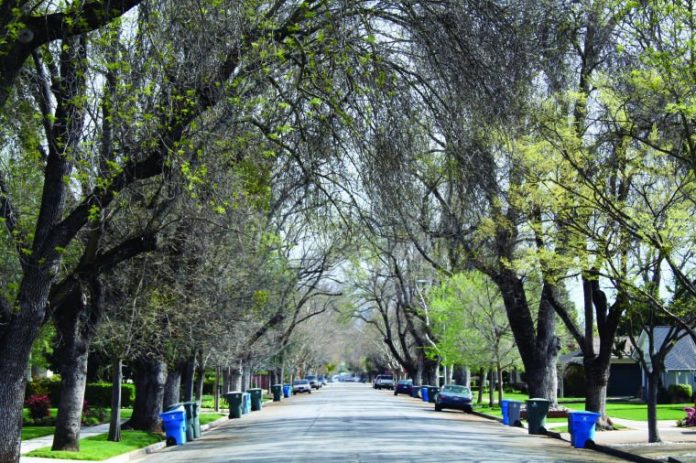There may be a reprieve for several iconic American elms slated for the saw, if an arborist’s inspection in June discovers that birds are nesting in the lush green canopy lining Fifth Street in the heart of Gilroy.
If that is the case, the staying of the saw will only last until the birds move on – much to the dismay of neighbors who are up in arms over the City’s decision to chop down four of the 100-year-old trees.
“We want to give the birds a chance to find other trees,” said Todd Barreras, an operations services supervisor with the City. “Our contractor will inspect the trees, and if we find birds nesting, we will hold off.”
The four trees will be cut down in June because they have succumbed to a twin-pronged attack from the elm leaf beetle – an insect accidentally introduced to the U.S. in the 1830s – and the ravages of old age. The combination of factors has left the infected trees weak and prone to limbs falling off; a danger the City is keen to avoid.
Barreras invited the Dispatch and locals to watch the inspection tentatively slated for June 4; a gesture meant to demonstrate that West Coast Arborists Inc. and the City are sticking to rules laid down by the Migratory Bird Treaty Act of 1918 and sections of the California Fish and Wildlife Code.
That may be of some comfort to concerned neighbor Elva Boyer, who will be keeping an eagle eye on the proceedings.
“There’s a lot of bird nests in those trees,” she observed. “Hopefully they’ll do the right thing.”
Boyer did her homework on laws surrounding nesting birds and is pleased that the City intends to play by the rules. She even went so far as to contact the California Department of Fish and Wildlife in order to gain a clear understanding of what the City can and cannot do.
“I figured that I was going to have to fight with them,” Boyer laughed.
She instead received a phone call from Barreras outlining exactly how the City will proceed if avian visitors are found in the upper reaches of the 50-foot elms. If that is the case, it will only temporarily prolong the majestic canopy offered by the towering elms until around August, when the birds migrate.
Boyer is trying to be as upbeat as possible about the impending removal of part of Fifth Street’s famously aesthetic tree tunnel.
“I’m going to enjoy the shade while I can,” she said.
Decision to cut down historic elms not taken lightly
The elms were planted at the turn of the 20th Century by Gilroy’s famed cattle Baron Henry Miller. Some are four feet in diameter and reach 50 feet or more above the road.
The ones that must be cut down will be replaced with Chinese Pistache trees, which are known for their radiant fall colors. Ten of these were planted on Fifth Street and in other locations around the city about two years ago during the last large scale removal of problem trees.
The four trees slated for removal are located in front of 790 Fifth St.; 820 Fifth St.; 831 Fifth St.; and 7490 Miller Avenue.
As more American and English elms succumb to the beetle and old age, Accolade elms, in addition to the Chinese Pistache trees, will also be used to replace the fallen.
David Stubchaer, operations division manager with the Public Works Department, previously reiterated: the City’s position on tree removal is not a decision that was hastily arrived at.
“It’s not that we want to take them down, but we have to face reality,” he told the Dispatch in March.
The notion of replacing the trees with an identical species, Stubchaer explained, was a non-starter because American and English elms are so susceptible to diseases and pests.
A report submitted to the City in 2011 by West Coast Arborists Inc. catalogued the devastation wreaked by the elm leaf beetle and the danger posed to residents by the affected trees. For Stubchaer, the risk of having dead tree limbs falling onto pedestrians is reason enough.
In addition to other incidents where tree limbs broke off and fell onto houses, “one guy got his truck smashed twice,” he recalled.
Everything that could have been done, was, Stubchaer added.
This includes the injection of chemicals into the ground, where it is absorbed by the trees’ roots and ultimately makes the leaves unpalatable to the elm leaf beetle without harming the tree. The City will continue this tactic, along with preventative pruning and additional watering, Stubchaer said.














